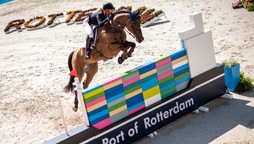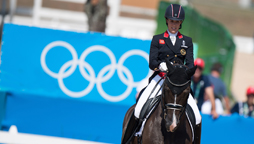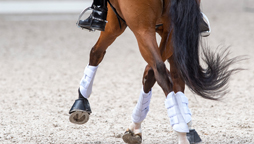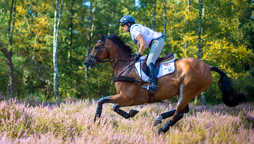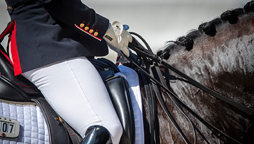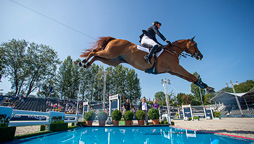World Championships
The major championships in equestrian sport run in a four-year cycle.
Year 1: European Championships
Year 2: World Championships
Year 3: European Championships
Year 4: Olympic and Paralympic Games
World and European Championships are overseen by the Fédération Equestre Internationale (FEI), the international governing body for equestrian sport. The next World Championships will be held in 2022 – eventing will take place in Pratoni del Vivaro, Italy, while dressage, showjumping and para dressage will take place in Herning, Denmark.
Each discipline at a World Championships has team and individual medals up for grabs, with gold, silver and bronze medals awarded to the combinations that make it onto the podium.
Vet inspections are carried out before the start of competition and again towards the end of competition to ensure that all horses are fit to compete.
Dressage
Dressage is a test of horse and rider's ability to perform a range of movements in harmony, across the gaits of walk, trot and canter. Seven judges mark the test from different points around the arena, which measures 60m x 20m. At a World Championships, national federations can put forward teams of three or four riders, with the three highest scores counting towards the final score. Nations unable to put forward a complete team can enter up to two combinations.
Grand Prix
The Grand Prix test is used to decide the team medals. Combinations each perform a set test, with judges marking all of the movements out of 10. The scores are then added up and an average taken which, when combined with additional marks for the riders’ seat and aids, is given as an overall percentage score. All four riders will ride the test, but only the three best rider scores are counted – the team with the highest overall percentage claims the team title.
Grand Prix Special
The top 30-placed riders from the team test then go forward to compete the Grand Prix Special, which is a predetermined test with a higher degree of difficulty than the Grand Prix. No scores are carried forward and, if qualified, all four team members can contest this round. The combination with the highest overall percentage score wins the individual title.
Freestyle
The top fifteen combinations of the Grand Prix Special compete in the Grand Prix Freestyle (also known as the kür). The Freestyle test sees combinations ride a floorplan set to music of their choice, based on a list of required movements, with additional marks given for artistic merit and degree of difficulty. If all four athletes from one nation are in the top 15, only three athletes may participate. No scores are carried forward from the Grand Prix Special and the highest percentage takes the title.
para dressage
Para dressage allows people with disabilities to compete at dressage – athletes are classified into five grades (I–V) depending on their levels of mobility, strength and coordination. Grade 1 tests are in walk, grade 2 and 3 include walk and trot, and grade 4 and 5 are comprised of walk, trot, canter and lateral work. To assist them during their tests, riders may use additional aids such as looped reins or callers, and federations can enlist 'friend' horses to stand just outside the arena to help the competing horse stay relaxed. In para dressage there are three judges marking each test, spread at different points around a 40m x 20m arena. National federations can put forward a team of four riders – teams can't contain more than two riders in any one grade.
Individual
All four riders compete against others in their grade in a set test. The test is marked in the same way as in dressage, and the combination with the highest percentage wins the individual medal for that grade.
team
All four riders ride a set test for their grade. The three highest scores are combined to produce an overall score, and the nation with the highest score wins. Riders can choose their own background music to be played during the test, but this won't be judged.
freestyle
In each grade, the top-eight combinations in the Individual test go forward to the Freestyle on the final day. Each combination rides their own floorplan set to music of their choice, based on a list of required movements, with additional marks given for artistic merit and degree of difficulty. No marks are carried forward from the Individual test, and the combination with the highest percentage wins.
Eventing
Eventing is a three-phase competition that's often likened to a triathlon. It's run over a period of four days and tests a combination's athleticism, bravery and harmony. Teams are made up of three or four combinations, with the three highest scores counting towards the team medals, and horses and riders must complete the competition together as a pairing.
Dressage (day one and two)
All combinations complete a predetermined test of movements in front of three judges. The judges award marks out of ten for each movement and, after combining the scores to give an overall percentage score, the score is then converted into penalty points (the higher the percentage, the lower the penalty score). For example, a percentage score of 70.00% becomes a penalty score of 30.00
Cross-country (day three)
Competitors tackle a course of around 40 solid obstacles, which can include logs, ditches, water, drops and corners. Penalties are incurred during this phase for a refusal, a run-out (at a fence) or for exceeding the time allowed, and these are added to the combination’s dressage score. Falls of horse or rider results in elimination.
Showjumping (day four)
Following a vet inspection to ensure that all horses are still fit to compete, combinations take on a short course of colourful fences. Penalties are added to their score for knocking down an obstacle, refusal at a fence or exceeding the optimum time. Riders can be eliminated for a second refusal or a fall.
The individual winner is the combination with the lowest number of penalty points accrued across the competition. In the team event, the scores of the three best-placed riders are added together to calculate the overall result.
Showjumping
The showjumping competition is contested over several rounds to decide team and individual honours. Combinations tackle set courses of knockable fences, with the aim being to leave the fences up and finish inside the optimum time. National federations can put forward a team of three or four combinations, with the three highest scores counting towards the final team result.
Speed round (day one)
All competitors contest one round against the clock. The final scores are converted into points – the rider with the fastest time and fewest accrued penalties for fences down or refusals is given zero penalties, with all athletes then given penalties dependent on the difference between their score and the rider on zero penalties.
Team competition and individual qualifier (day two and three)
All combinations complete an initial qualifying round, before the top-ten best teams and the top-60 athletes go forward to compete in another round that acts as a second individual qualifier and also as the final of the team competition. The team result is calculated by adding together the three best-placed athlete scores after the first and second qualifying rounds.
Individual final (day four)
The third competition is split into two rounds – A and B. Round A is contested by the top-25 combinations following the second round of competition. The 12 best-placed combinations after Round A go through to Round B to decide the individual placings. The combination with the lowest number of penalties at the end of the competition is declared the winner.
